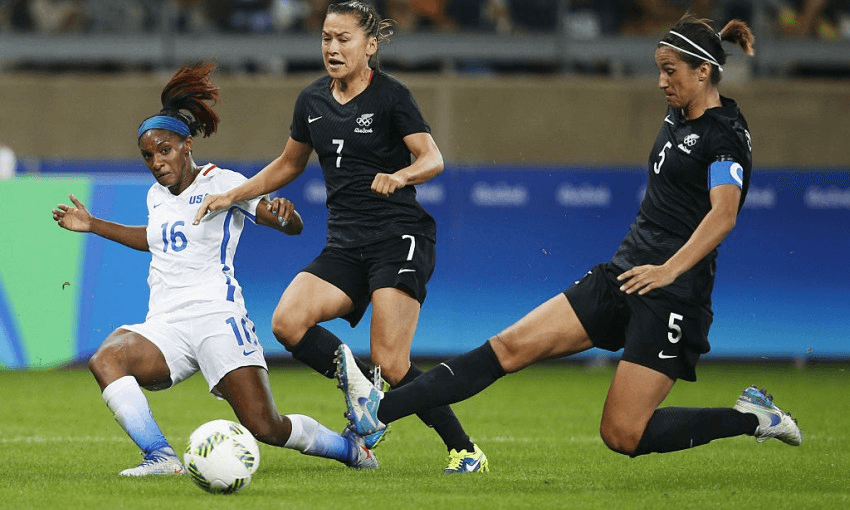The Football Ferns are about to get equal pay to the male All Whites when they represent New Zealand. It’s a huge step for the sport, but will it lead to genuine equality across football? Read on in today’s cheat sheet.
What’s all this then?
For what is believed to be the first time in the world, a women’s international football team will be paid the same amount to play for their country as the male team. And it’s happening in New Zealand. Under a new collective agreement Football Ferns players will get equal pay for international games, prize money for wins, and payment for use of image rights as the All Whites.
That seems massive. Is it?
It is, in a way. Being an international footballer for New Zealand alone isn’t massively lucrative. Both teams play reasonably infrequently, and the vast majority of games are in clumps for tournaments and short tours. The All Whites for example had the Confederations Cup and some World Cup qualifying games last year, and apart from that played three times. For the women, there were four games in the invitational Cyprus Cup, and two two–match tours. It’s not a lot of footy, but then again no countries really play huge numbers of international games in any given year.
That doesn’t make it sound massive at all.
Where it is significant is the recognition of the fact that football in New Zealand is a sport that absolutely should be equal, and that needs to be encouraged. Football participation rates for both girls and boys are whopping between the ages of 5–14. But that starts to drop away for girls in their mid to late teenage years, and adulthood. Why? Well, everyone has dreams, but some are more realistic than others. For a teenage boy who’s reasonably good at football, there is a huge potential upside to keeping on playing. You might get fame and fortune! Or even just be able to eke out a living as a pro. But the possibility is there. For teenage girls, that’s only recently been any sort of possibility.
Hang on, aren’t footballers generally wildly wealthy?
Two problems there. Firstly, no. The average footballer is not on 50,000 pounds a week, like All Whites striker Chris Wood earns for his club Burnley. A few of course are on even more than that but outside of the big European Leagues, the salaries are a bit more modest. Take for example the pay rates of Wellington Phoenix players back in 2012: The salary cap for the whole team, for the whole year, was a bit over $3 million. The guaranteed minimum was $60,000. With about 20 in the squad in any given year, that doesn’t give a lot of room for millionaires.
Secondly, all of that applies to male players. For women, it’s nothing like that at all. The first fully professional women’s football league was formed in 2000. It called itself soccer and was based in the USA. Two professional women’s competitions folded before the formation of the National Women’s Soccer League, which has shown promising signs since it was formed in 2012. Most teams have average match attendances in the mid–thousands, though the Portland got about 17,000 fans per game over 2017. To put those numbers in context again, the hardy Phoenix get a shade over 6,000 a game through the doors.
Three New Zealanders are scattered across the NWSL, and one of them, Rosie White, had to switch teams after her club folded. The salary levels aren’t amazing either – a minimum pay over the season of $15,000 USD, out of a $350,000 total salary cap. And it’s not much better in Europe either, where an average salary is about $30,000 a year.
How does anyone make a go of being a professional woman soccer player? Sorry, football. Football.
For more than a few incredibly good Football Ferns players, it just wasn’t possible. Jasmine Pereira had to walk away from the game at the age of just 20 – she had already played 10 games for New Zealand. And absolute ball–kicking boss Abby Erceg retired from international football, because “without being able to justify my involvement any longer, I will be stepping back in the hopes to create change for the current and future generations of NZ footballers.” But there’s an upshot to that too – citing a change in attitude from NZ Football towards the women’s game, Erceg announced in February she was coming out of international retirement, and will continue adding to her record number of caps.
Does any of this matter though? Aren’t New Zealand crap at football?
It’s a delicate one. The men are undoubtedly miles off the pace in world football. Bus parking defence at the 2010 World Cup aside, there has been little to celebrate from the All Whites for a long time. But that’s not quite the same for the Football Ferns. They’re currently ranked 20th in the world, and picked up a win against the rather impressive Colombia at the last Olympics. The World Cup record remains fairly poor, but the spartan conditions of their standard travel as a team has long been considered a factor in their tournament results. And travel is being equalised too, which means business class flights.
The final word.
The Football Ferns play will play in Wellington against a likely classy Japan in June. Go and watch them play! There’s no reason why they couldn’t go on to become one of our more successful international sports teams, so like a true football fan, jump on the bandwagon before it gets too crowded.
The Bulletin is The Spinoff’s acclaimed, free daily curated digest of all the most important stories from around New Zealand delivered directly to your inbox each morning.

